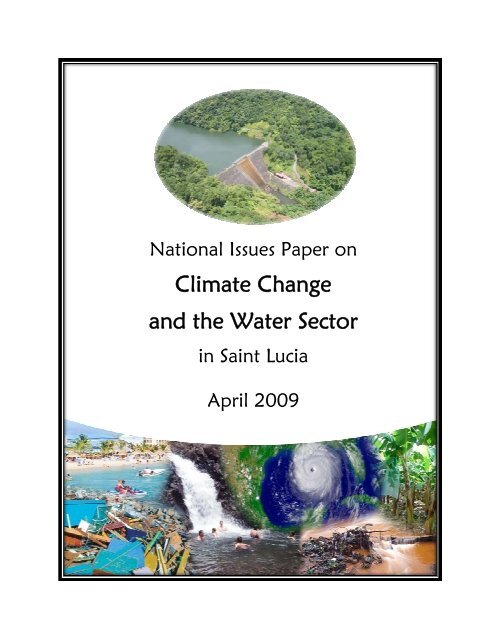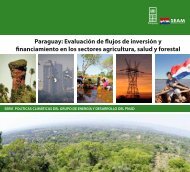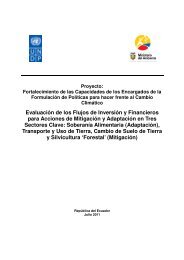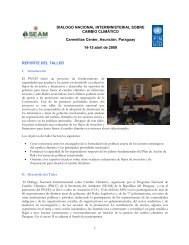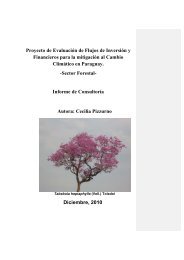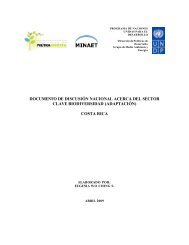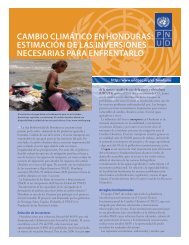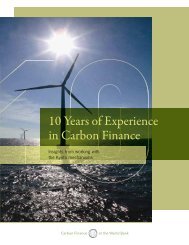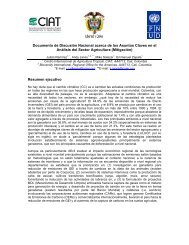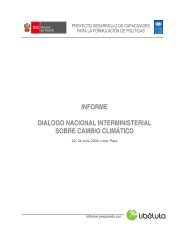St Lucia - UNDPCC.org
St Lucia - UNDPCC.org
St Lucia - UNDPCC.org
You also want an ePaper? Increase the reach of your titles
YUMPU automatically turns print PDFs into web optimized ePapers that Google loves.
Saint <strong>Lucia</strong>: Issues Paper on Climate Change Adaptation & the Water Sector April 20091.0 Why water is a key sector for Saint <strong>Lucia</strong>Saint <strong>Lucia</strong> has a fragile economy which has been evolving over the years from one beingheavily dependent on Agriculture specifically banana production to one which isdependent on Tourism and Other Services (80% GDP), Agriculture (5% GDP) andIndustry (15% GDP). Freshwater is a fragile, finite and vulnerable resource vital tohuman, economic and environmental sustainability and influences national prosperityand quality of life. The water sector is a cross cutting sector and plays an important rolein all sectors in Saint <strong>Lucia</strong> and therefore any impact of climate change on the watersector could have far reaching repercussions on the economy of the country and affectlife in general, being a catalyst for economic development and a vehicle forempowerment and poverty alleviation.Over the years there has been a significant focus on the water sector in Saint <strong>Lucia</strong> withthe government initiating a reform of the sector in 1999 which is still ongoing. It is clearthat significant investments are required to bring the sector to the level required to meetthe current demand and future needs. Water demand continues to change rapidly incertain areas, for example the extreme north due to high infra structural developmentand migration of people into areas in the north and other major centers of commercialactivity in the south. In general there is water supply versus demand deficit, island wide,and this is affected directly by rainfall distribution.Although there have been continuous improvements, the potable water supply, has inrecent years, been severely affected by pressures of increased demand as a result of socio-economic development, destruction of upper watersheds, increasing exploitation of therivers and wetlands, and an inefficient, inadequate and aging water distribution network.The ability of the Water and Sewerage Company (WASCO) to meet the current demandfor water, island wide is as a result of a combination of marginal river base flowsexperienced during the dry season and high turbidity during the rainy season.It is widely suggested that present water demand is exceeding the available supply andthat the potential increase in future demand can only serve to exacerbate this deficit.While the available data does not allow for an exact determination of supply/demanddynamics, data of the potential supply/demand situation within various sectors andzones and for the island as a whole point more to a suppressed demand than a realdeficit [AGRICO, 2001].Freshwater supplies are highly susceptible to normal climate variability. This results inperiods of excess rainfall which can lead to flooding as well as periods of below normalrainfall which leads to drought conditions. During such periods of heavy rainfallwatercourses are susceptible to siltation which impacts significantly on raw water quality.In addition there are a number of anthropogenic activities currently affecting the qualityof Saint <strong>Lucia</strong>’s rivers and freshwater systems. These include: housing, agriculture, waterabstraction, sewage disposal, solid waste disposal, tourism, fishing, river sand mining,manufacturing, river bathing and picnicking, and river alteration.Page | 2
Saint <strong>Lucia</strong>: Issues Paper on Climate Change Adaptation & the Water Sector April 2009Although it is suggested that the island currently has sufficient freshwater to meet alldemands, a key concern is that the resources are unevenly distributed temporally andspatially. Therefore it is absolutely necessary that an Integrated Water ResourcesAssessment be conducted to ascertain the actual available water resources as well as thewater resource potential. The need for an implemented Integrated Water ResourceManagement Plan cannot be overstated.2.0 Key Aspects of the Water SectorSaint <strong>Lucia</strong> is a small island developing country and experiences year‐round warm,humid conditions associated with the tropical marine climate which can be attributed toits location. The geographical location of the island results in the occurrence of tropicalstorms and hurricanes during the rainy season. The island’s weather is influenced by theAtlantic High Pressure system, surface, mid and upper level troughs/lows, the InterTropical Convergence Zone, tropical waves and cyclones and the occasional frontalsystem. The island experiences wet (June – November) and dry (December – May)rainfall seasons annually. In the wet season the quantity of rainfall is influencedprimarily by the frequency and intensity of tropical waves, depressions, storms andhurricanes.Saint <strong>Lucia</strong> is a volcanic island and is geologically composed of impermeable rock.Therefore movement of water into underground reserves is very limited. Waterresources are as a result from surface sources in rivers, wetlands, streams and springs.There are thirty-seven (37) main sources of surface run-off (figure 1) and fewgroundwater sources. Surface water catchments are relatively small, with steep slopeson which run-off occurs fairly rapidly. Surface water yields for potable water purposesvary due to increased abstraction and in some cases soil and chemical contamination.Surface water is heavily exploited for municipal and agricultural purposes.The island’s freshwater requirements are met through an integrated network of riverintakes, treatment plants, transmission pipelines and distribution systems. These systemcomponents are under operation and control of the Water and Sewerage Company(WASCO). With respect to the potable water supply there are four (4) major watersupply systems in the country: North - Roseau Dam and Hill 20, South - Grace andBeausejour. The supply to the treatment plants is from water streams through bothgravity and pumped conveyance systems. The above mentioned systems treat the rawwater in filtration plants and then disinfect.There are approximately 56,000 customers (households and commercial establishments)served by the system, distributed between the networks in the north and south [WASCO,2009]. As noted earlier there are a number of challenges to WASCO in the provision ofan adequate water supply island wide.Page | 3
Saint <strong>Lucia</strong>: Issues Paper on Climate Change Adaptation & the Water Sector April 2009Figure 1 : Watersheds in Saint <strong>Lucia</strong>Inter‐annual variability in the Southern Caribbean climate is influenced strongly the ElNino Southern Oscillation (ENSO). El Niño episodes bring warmer and drier thanaverage conditions between June and August and La Niña episodes bring colder andwetter conditions at this time [Saint <strong>Lucia</strong> Hires Report]. Observational records andclimate projections provide abundant evidence that freshwater resources are vulnerableand have the potential to be strongly impacted by climate change, with wide-rangingconsequences for human societies and ecosystems [IPCC, Special Report on ClimateChange & Water].A thorough understanding and response to climate change is critical for small islanddeveloping states (SIDS) like Saint <strong>Lucia</strong>. Despite the fact that Saint <strong>Lucia</strong>’s contribution tothe source of this anthropogenic change is minimal, by virtue of inherent characteristicssuch as geographic location, small land mass with high proportion of low lying coastalPage | 4
Saint <strong>Lucia</strong>: Issues Paper on Climate Change Adaptation & the Water Sector April 2009areas, the island is rendered vulnerable to the anticipated impacts of climate change onthe water sector. It is expected that climate change will result in impacts on waterresources sources as follows, through :1. Changes in surface and groundwater systems2. Changes in water quality3. Increased flooding4. Increased droughts5. Changes in water temperature6. Changes in water chemistry7. Increased water erosion and sedimentation8. Decreased freshwater availability due to saltwater intrusionTable 1 below highlights the anticipated impacts on the Fresh Water Resources asindicated in the Government of Saint <strong>Lucia</strong> First National Communication on ClimateChange.IMPACTSTable 1 : Anticipated Impacts on the Fresh Water Resources[Source: CC FNC, GOSL]IMPLICATIONSClimate Change Factor: Sea Level Rise• Sea level rise may precipitate theintrusion of salt water into fresh waterlenses, particularly in low- lying coastalareas.• While there is little use of ground water inSaint <strong>Lucia</strong>, saline intrusions will reducethe quantity and quality of potentialsource of potable water.• Irrigation with brackish water will mostoften destroy crops and ruin soils.Climate Change Factor: Tropical <strong>St</strong>orm Activity• Destruction and/or modification ofexisting aquatic ecosystems caused by theincreased frequency and intensity ofprecipitation.• Soil erosion resulting from increasedsurface run off on exposed soils.• Siltation of river systems duringperiods of increased rainfall.• Temporary increase in water supply.• Damage to water intakes, dams andreservoirs leaving settlements withoutwater or providing poor water quality.• Increased social and economic cost toensure that these facilities aremaintained.• Degradation of the habitats of species offlora and fauna which occupy the aquaticecosystems, leading to a loss ofbiodiversity.Page | 5
Saint <strong>Lucia</strong>: Issues Paper on Climate Change Adaptation & the Water Sector April 2009IMPACTSClimate Change Factor: PrecipitationDecreased precipitation:• Periods of low precipitation arelikely to be accompanied by extendeddry periods.• Increased frequency & Intensity ofprecipitation:• Destruction and/or modification ofexisting aquatic ecosystems.• Siltation of river systems.• Increased incidence of flooding.• The likelihood of cross contaminationfrom leaching of pit latrines into floodplains increases during flooding.Climate Change Factor: Temperature• Possibility of excessive evapo-transpirationassociated with the level of temperatureincreases of the high precipitation scenario.• Municipal demands are likely to increase ashigher temperatures lead to increased waterconsumption.IMPLICATIONS• Extended periods of drought leading todecreases in water supply for domestic andother use.• Consumers who normally maximizerainwater stores may need to increaseconsumption of treated water to meetdomestic needs.• The elevation of water rates to discouragewastage and greater efficiency ofproduction may be another necessaryoption.• Temporary increase in water supply.• Damage to water intakes, dams andreservoirs and/or pollution of water sourcesleaving settlements without water orproviding poor water quality.• Increased social and economic cost toensure that these facilities aremaintained.• Degradation of the habitats of species offlora and fauna, which occupy the aquaticecosystems leading to a loss ofbiodiversity.• Loss of livestock and crops• Increased freshwater outflows will reducethe salinity of coastal waters withconsequences for fisheries, as coral reefs andsea grass beds no longer support theirnormal biodiversity.• Loss of soil moisture, which will impact on cropproduction.• Dwindling basal flows may alter thebiophysical parameters of rivers and wetlandssufficiently to affect breeding cycles, offspringand parent fecundity, offspring survival andoverall species resistance to environmentalstresses such as disease and fishing effort.Page | 6
Saint <strong>Lucia</strong>: Issues Paper on Climate Change Adaptation & the Water Sector April 20093.0 Adaptation Options for the Water SectorThe Climate Change First National Communication [CCFNC] for Saint <strong>Lucia</strong> indicatedthat adaptation involves developing and institutionalizing various levels of capacity, aswell as developing expertise and building knowledge through research and monitoring.Such adaptation measures are most effective if implemented early while the varioussystems are still intact. It is suggested that anticipatory approaches can also greatlymitigate the need for forced ad hoc responses at a subsequent date when loss ofresources and poorly planned developments will likely limit the range of adaptationoptions available [CCFNC]. The Climate Change First National Communication[CCFNC] highlighted the following as select adaptation options for Saint <strong>Lucia</strong> for theWater Sector:1. Reductions in line losses2. Accurately reflecting costs of water supply3. Restoration of riverbanks and wetlands4. Water conservation5. Public awareness6. Improved management of forest resources including private forests7. <strong>St</strong>rengthening data collection8. Development of a national water management planTo this end the Government of Saint <strong>Lucia</strong> in recognition of the potential implications ofthe impacts of climate change on water resources remains committed to addressing theseissues as indicated in The Saint <strong>Lucia</strong> National Climate Change Policy and AdaptationPlan (2003). The following articulates the government’s commitment as stated in theplan [GOSL, CCPAP] :In addressing these and other related issues, the Government of Saint <strong>Lucia</strong>, incollaboration with other relevant entities, will:1. Develop or improve the basis for sound decision making by promoting andfostering the developing of capacity to undertake research into and analysis of therelevant climate change processes (including forecasting and data collection).2. Undertake a comprehensive inventory of all water resources including surface andground water.3. Promote the strengthening of national water management agencies to ensure thesound management of the island’s water resources.4. Develop a long-term national water management plan which incorporates andaddresses Climate Change concerns including catchment and watershed protectionand saltwater intrusion.Page | 7
Saint <strong>Lucia</strong>: Issues Paper on Climate Change Adaptation & the Water Sector April 20095. Undertake reforestation and other measures to increase the resilience ofwatersheds and catchments to maximize water availability and to reduce soil erosionand sedimentation.6. Assess and address needs for water storage and distribution infrastructure toensure water availability during drought periods.7. Promote initiatives to identify and, where necessary, exploit non-traditionalwater sources such as groundwater.3.1 Additional Considerations : - Adaptation MeasuresBeyond the areas highlighted by Government in the Climate Change Policy andAdaptation Plan the following needs to be considered:1. The Water Sector Reform process when concluded this year will result in a newcompany to manage the provision of services to the sector as well as regulatoryenvironment. This is critical as investments under this program are key to the watersecurity of the country and by extension result in a reduced vulnerability of thesector.2. Map areas susceptible to saline intrusions and develop alternative sources of watersupply. Also explore the use of desalination techniques for saline tainted watersource.3. It is important not only to consider supplying water demand from conventionalsources such as rivers but also look at alternatives to these sources. The following aresources that can be used to augment the supply to facilitate long term, sustainabilityof the water resources.• Wastewater Reuse : - Waste water can be reused depending on its origin and thepurpose for which it is required. Domestic wastewater is perhaps a better choiceof wastewater over industrial wastewater but of course this depends on the natureof the industry. Domestic wastewater for example can be used for irrigation ofgolf courses in the hotel sector. Hotels tend to consume a significant amount offresh water at the expense of local consumers. This option can allow a reductionin the potable water demand of hotels.• <strong>St</strong>orm Water Collection & Use : - This is an option that is worth looking into inmore detail. It is evident in Saint <strong>Lucia</strong> that a significant amount of water is wastedand simply flows into the sea during and after periods of rainfall. If this water iscollected and treated it could be used for normal consumption.• Ground Water : - Due to the general impervious nature of the volcanic bedrockvery little water that fall as precipitation is stored as ground water. As indicatedpreviously the reserves are inadequate for major consumptive purposes. HoweverPage | 8
Saint <strong>Lucia</strong>: Issues Paper on Climate Change Adaptation & the Water Sector April 2009in recent times there has been exploration of deep groundwater reserves. It isworth pursuing further.• Desalination : - In this case the seawater resource is abundant but all factors needto be considered to ascertain the economic feasibility. This can be used as a lastresort due to the high cost associated with the process. It should be noted that dueto improved technology some desalination plants prove to be comparable interms of cost but this is dependent on the specific situation and the cost of theoptions available. One option is the utilization of brackish water or slightly salinewater from waters contaminated by salt water intrusions.• Rainwater Harvesting: - This is the collection and concentration of rainwater andrunoff for irrigation of annual crops, pastures and trees, domestic consumptionand livestock consumption. Catchment areas for rainwater harvesting are rooftops, small ground surfaces, courtyards, streets, public squares, slopes and largecatchment areas feeding seasonal rivers. <strong>St</strong>orage mediums consist of : underground– soil, sediment, cisterns; above ground tanks and jars, ponds, reservoirs. Roof toprainwater harvesting is already being explored in some areas in Saint <strong>Lucia</strong> withdomestic water supply problems. In recent times there have been a number ofprojects supported by the European Union, Government of Saint <strong>Lucia</strong>, CaribbeanEnvironmental Health Institute (GEF funded) promoting the widespreadreintroduction of rainwater harvesting.3.2 Adaptation Measures under consideration and implementationFurther to the identification of adaptation measures listed previously, the followinghighlights initiatives being pursued :1. Water Sector Reform Process to address the following:a. Regulation and Management of Water Resources to include the developmentof an Integrated Water Resources Management Plan, identification ofalternative sources of water (groundwater or desalination), promote waterconservation, establish system and sustain collection of water resources data.b. Regulation and Management of Provision of Services to include theestablishment of a new company to facilitate installation and maintenance ofnew infrastructure and maintenance of old infrastructure and systems.2. Water Conservation and Demand Management :a. Introduction of rainwater harvesting schemes.b. Promotion of water conservation in the dry season.c. Promotion of the use of water conservation devices.d. Wastewater reuse.e. Water demand reduction.Page | 9
Saint <strong>Lucia</strong>: Issues Paper on Climate Change Adaptation & the Water Sector April 20094.0 Key issues in Assessing Investment and Financial FlowsIn assessing investment and financial flows when dealing with climate change adaptationin the water sector a number of issues need to be considered. Water ResourceManagement encompasses a wide range of sectors and is impacted by areas such asagriculture, forestry, urban environment, reservoir development, wetlands, groundwaterreserves. Some of the major issues which must be considered are as follows:1. Inadequate Natural and Water Resource Management.2. Water Resource Availability and Quality – There is a water supply deficit islandwide based on the supply and demand of the various water systems. This isparticularly acute in the dry season. Poor raw & treated water quality is an issue insome areas. It is necessary to assess the impact of agricultural intensification as wellas deforestation on water quality and availability. Soil erosion, land degradation,sedimentation, poor land drainage, uncontrolled rural development, are issuesthat require consideration.3. Current <strong>St</strong>ate of the Water Sector i.e. Investments required to ensure thesustainability of the sector with normal variability and no climate change.Currently the Water Supply Infrastructure is inadequate.4. Inadequate Data availability – Current & Historic Rainfall, <strong>St</strong>ream Flow, Runoff,Water Demand & Supply.5. Absence of Implemented the Water & Land Use Policy as it relates to WaterResource Management.6. Inadequate Institutional and Regulatory Capacity.7. The extent to which non action in relation to the water sector investments willexacerbate the climate change impacts.8. How does one apportion the adaptation costs to climate change.It is clear that climate change will have impacts on the availability of water for thepotable water supply. Even without the effects of climate change and variability there aresignificant challenges to the sector. It should be noted that the First NationalCommunication [FNC] was based on expert judgment and included a situational analysisof the sector. It did not contain detailed analyses based on scenario generation andmodeling of climate change conditions and impacts. The Second NationalCommunication is currently ongoing and the Vulnerability and Adaptation componentwhich has not yet been untaken is expected to produce a more detailed data collectionand analysis of the sector resulting in scenario generation and a quantitativedetermination of the vulnerabilities and associated costs of adaptation.Page | 10
Saint <strong>Lucia</strong>: Issues Paper on Climate Change Adaptation & the Water Sector April 20094.1 ConstraintsIn the assessment of climate change impacts on the water sector, one of the major issuesis quantifying the resource. It is clear that “if you cannot measure, it you cannot manageit”. It is necessary that the availability of the resource be measured. Only then can oneclearly determine the extent to which climate change will have adverse effects on theresource and the extent to which the adaptation measures need to be effective.It should be noted that the major issues emanating from this analysis are issues that existeven with the potential effects of climate change. It is there difficult to apportion costs ofadaptation measures for climate change impacts as most of these investments wererequired anyway to deal with existing challenges to the sector. There are a number ofconstraints in this sector:• Data availability – there is a paucity of data. It is necessary to have wellestablished records of Current & Historic Rainfall, <strong>St</strong>ream Flow, Runoff, WaterDemand & Supply. The data available is insufficient to facilitate proper planningand as such the establishment of a system of continuous collection of data isimportant. (Legal Responsibility of the Water Resources Management Agency(WRMA).• Inadequate Water Supply Infrastructure – the infrastructure is over 50 years oldand is in dire need of replacement. (Legal Responsibility of the Water Company(WASCO/ NewCo).• Absence of implemented water & land use policy as it relates to water resourcemanagement and inadequate natural and water resource management. (LegalResponsibility of the Water Resource Management Agency (WRMA)).• Inadequate Institutional and Regulatory Capacity – absence of a functional WaterResources Management Agency and National Water and Sewerage Commission asmandate by law.It should be noted the above mentioned constraints will be dealt with through theestablishment and operationalization of the Water Resource Management Agency(WRMA) and the Water and Sewerage Commission (WSC) and the New WaterCompany (NewCo) which is expected within the next 3 months.4.2 Modeling and Scenario Limitations and/or AssumptionsIt should be noted that there are a number of limitations as it relates to monitoring andscenario generation as follows:1. Availability of data required to develop models based on various scenarios.2. Inadequate national capacity to develop the required models for the region. It istherefore necessary to seek relevant expertise in countries where English is not thePage | 11
Saint <strong>Lucia</strong>: Issues Paper on Climate Change Adaptation & the Water Sector April 2009primary language. As a result the language barrier poses challenges with respect tocapacity building.3. Inability to purchase relevant models and modeling software.4. Due to differences in models for various regions, technology transfer is limited.5. Application of available models to the local situation is limited and also inabilityto select appropriate models.6. Models utilized for local application are scaled down from global models and assuch the accuracy of models and scenario generation is assumed.7. Ability to communicate to policy makers information arising from models. Itshould be noted the climate change timelines are long term (30, 50, 100 yearsetc). There is a challenge to convince the policy makers of the need to act nowand address such a long term phenomena in the short to medium term withintheir shorter political term of office.It should be noted that based on the above, a key approach developed to move forwardespecially with respect to completion of the Second National Communication’s,Vulnerability and Adaptation Assessment is as follows:1. Utilize the Climate Change expertise in the region from Cuba, Jamaica andBarbados. This will deal with the language barrier as well as ensure that the mostappropriate models are selected and modified for Saint <strong>Lucia</strong> since these countriespossess the expertise required.2. This assessment has a strong capacity building component and as such the localexpertise involved will be trained where necessary to ensure the country iscapable of conducting future assessments.5.0 Assessment of Investment and Financial Flows5.1 Proposed Methodological Approach in Assessing Investmentand Financial FlowsThe following highlights the approach being proposed to assess investment and financialflows:1. Development and application of appropriate models to clearly articulate anticipatedclimate change scenarios and the effects on the sector. It should be noted that theFirst National Communication did not utilized models. It is expected that models willbe used for the Second National Communication. It is expected that a combination ofglobal and regional models will be utilized in the SNC Vulnerability and AdaptationAssessment including the use of the PRECIS model and a compatible global model.Page | 12
Saint <strong>Lucia</strong>: Issues Paper on Climate Change Adaptation & the Water Sector April 20092. Situation Analysis using a basic scenario with or without climate change. In assessingimpacts and costs associated with climate change adaptations it is necessary to assessthe situation “with and without climate change”. There are a number of interventionsthat are required even without climate change being an issue. It should be notedhowever that if these issues are not addressed on their own merit, the effect ofclimate change will only exacerbate the situation.3. Assessment of costs anticipated with the existing challenges without the application ofclimate change scenarios.4. Assessment of costs associated with climate change. This is expected to be initiatedduring the preparation of the Second National Communication for the Vulnerabilityand Adaptation Assessment. It should be noted that the water sector reform processhas generated costs associated with the improvement in the level of service of thesector including critical investments in areas of water supply and sewerage servicesrequired to sustain the sector. This figure has been estimated to be EC$1.7 billion overa 30 year period [<strong>St</strong>one & Webster, 2004]. This does not take into considerationadaptation options.5. Comparison of implementation timeline of normal development objectives in thesector. Determination of extent to which climate change impacts would have aneffect in advance of the normal development commitments.6. Establishment of a system for allocating investments and financial flows to climatechange adaptation. This is expected to be initiated during the preparation of theSecond National Communication for the Vulnerability and Adaptation Assessment.5.2 Institutional Arrangements and Key <strong>St</strong>akeholdersThere are a number of legal instruments and stakeholders as it relates to the water sectorin Saint <strong>Lucia</strong>. Figure 2 below highlights the key players in the sector as well as therelevant legal instruments. The key players in the sector are the Water ResourceManagement Agency (in embryonic stage), National Water and Sewerage Commissionand Water Company (new company to be formed soon), Ministry of Health PublicHealth Department.Page | 13
Saint <strong>Lucia</strong>: Issues Paper on Climate Change Adaptation & the Water Sector April 2009Figure 2 : Saint <strong>Lucia</strong> Water Cycle, Associated Legal Instruments and Main Actors[Source : CANARI, T. Geoghegan, 2002]5.3 National Sources of Finance and Investment for the SectorTo date water sector reform initiatives have been financially supported by the following :Government of Saint <strong>Lucia</strong>, World Bank, Caribbean Development Bank, EuropeanUnion, Government of France (AFD). It is expected that there will continue to be donorsupport for the sector. As well, with the new regime of private sector involvement it isexpected that much needed investments will also be met by private sector interests.Since 1998, Government of Saint <strong>Lucia</strong> recognized the need for reforming the WaterSector. The major reasons being the poor performance, unreliability of supply, lowcoverage of sewerage, poor financial performance and low level of capital investmentfaced by the then Water Company. The Water Sector Reform Project (funded by theCaribbean Development Bank, the World Bank, WASCO and the Government of Saint<strong>Lucia</strong>, EC$ 24 million) aimed to prepare an adequate legal and regulatory framework forthe private delivery of water and sanitation services throughout Saint <strong>Lucia</strong>. Theproject’s objective was to prepare the Water Company for the transition from a publiclymanaged utility, to a privately managed and operated company. Additionally, thePage | 14
Saint <strong>Lucia</strong>: Issues Paper on Climate Change Adaptation & the Water Sector April 2009project aims to safeguard the integrity of the critical water supply and wastewaterservices infrastructure through the implementation of urgently needed capital works inthe region of EC$ 1.7 billion over a period of 30 years. Table 2 illustrates some criticalinvestments anticipated in the short to medium term financed by the new watercompany, the Government of Saint <strong>Lucia</strong>, and various lending institutions and aidagencies.One of the major components of the Project was the strengthening of the Legal andRegulatory Framework. To this end Government focused on drafting the necessary laws,regulations and licenses for the sector. This is expected to facilitate significant andsustainable private sector participation in the water and sewerage sector while protectingthe interests of Saint <strong>Lucia</strong>’s consumers.Another component was the strengthening of the Environmental and Water ResourceManagement Framework. This is intended to create an enabling environment and waterresource management framework for the delivery of sustainable water supply andsewerage services and to integrate water supply needs with environmental management.An Institutional <strong>St</strong>rengthening Program within the Water Company aimed to enhance thecapacity of the company, with a view to improving the delivery of reliable andresponsive service to its customers in the short to medium term. This involves thedevelopment and application of relevant industry accepted technical, financial,accounting and commercial information systems and procedures and appropriate stafftraining in key operational areas to upgrade their skills.The implementation of a critical capital works program was another aspect of theproject. Due to the age of the system components, many facilities are approaching orreaching the end of their operating life. The objective of the program is to preventfurther deterioration of the water supply and sewerage system, through theimplementation of critical capital works to impact positively on the reliability and qualityof service in the short term. The rehabilitation works that are planned under the projectare those urgently needed to enhance the reliability of the system and to ensure that theimprovements to these systems redound to the benefit of the population. Additionally,the improved systems are more likely to attract private sector capital, to fund furtherexpansion and upgrading of the water supply and sewerage networks.The projects currently being implemented in the sector are critical to mitigate against theproblems resulting from the inadequate water supply systems island wide. It is thereforeimportant these be taken into consideration as any scheme of adaptation options shouldbe in synergy with each other and benefit from each other. It is further suggested that ascheme be devised to apportion cost to climate change adaptation as some of therecommendations are required without any climate change impacts.Page | 15
Saint <strong>Lucia</strong>: Issues Paper on Climate Change Adaptation & the Water Sector April 2009Table 2 : Schedule of Investments (Short to Medium Term)[Source : Diagnostic of the Utility, Santander Investment Services, February 2006]INVESTMENT SCHEDULEMillionsUS$2006-20102011-2015 2016-20202021-2025NORTH AND SOUTH SERVICESHydrological study of the watersheds 0.50 0.50<strong>St</strong>udy of new water sources 0.50 0.50Geographic Information System 0.50 0.50Commercial Information & Billing System 1.00 1.00Administration Systems 0.20 0.20Offices 0.20 0.20Office Equipment and Miscellaneous 0.20 0.20Vehicles and Mobile Equipment 0.20 0.20NORTHERN REGIONPhysical Losses Reduction 7.50 2.00 2.00 2.00 1.50Meters 2.00 1.00 1.00Normalisation & renovation of existingconnections4.74 2.00 2.00 0.38Commercial System (collection improvement) 0.30 0.20 0.10Bulk Metering 0.20 0.20Installations modification for better operation 2.00 1.00 0.50 0.50Treatment Plants Improvement 0.50 0.50Pumping <strong>St</strong>ations Improvement 0.65 0.65Reservoirs improvement 1.00 1.00Sewer Treatment Plant 2.00 1.00 1.00Sewer Network Extension 1.00 0.50 0.50Roseau Upgrade 10.00 5.00 5.00SOUTHERN REGIONDennery 2.92 2.92Micoud 3.62 3.62Vieux Fort 3.89 3.89Choiseul 1.85 1.85Soufriere Canaries 1.60 1.60Physical Losses Reduction 4.50 2.00 2.00 0.50Renovation and Normalisation of existingconnections1.64 1.00 0.64Commercial System (collection improvement) 0.20 0.20Meters 1.00 0.50 0.50Installations modification for better operation 1.00 0.60 0.40Troumasse River Intake 4.00 2.00 2.00TOTAL INVESTMENTS 61.41 31.53 10.64 10.38 8.50Page | 16
Saint <strong>Lucia</strong>: Issues Paper on Climate Change Adaptation & the Water Sector April 20096.0 ConclusionSaint <strong>Lucia</strong>’s Climate Change Adaptation Policy & <strong>St</strong>rategy [2003] is premised on anacceptance that climate change is happening and it will continue to occur even ifimmediate steps are taken to reduce global warming. Also accepted is the fact that theeffects thereof are more than likely to have a profound, and in sum, adverse, impact onthe economic, social, and environmental aspects of life in the country.The water service provider (Water and Sewerage Company Inc) has the responsibility tosupply consumers with potable water; however the Government and People of thecountry being the custodians of the water resources of the country bear responsibility forwater resource management through a recently established Water Resource ManagementAgency. Due to the fragile nature of the water resource it is necessary to promote a jointresponsibility of its management and promotion of adaption measures to deal withclimate change. All citizens have to play a part from a domestic level to a commercialand industrial level.Such effects on water resources will have far reaching consequences on all sectors,domestic consumers, commercial consumers, tourism plants, industrial consumers, theagricultural sector, the health sector. It is clear that Water is Life. Inadequate supply ofwater for all sectors can result in a collapse of the economy as there are very few optionsto do otherwise.7.0 Bibliography & References:1. National Climate Change Adaptation Policy, 2003, Government of Saint <strong>Lucia</strong>.2. Saint <strong>Lucia</strong>’s Initial National Communication on Climate Change, 1997.3. Climate Change and Water, IPCC Technical Paper VI, June 2008.4. Saint <strong>Lucia</strong> Hires Report, UNDP Climate Change Country Profile.5. Saint <strong>Lucia</strong> Water Policy, 2003.6. Report on National Water Situation and Assessment of National Water Profileprepared by AGRICO Ltd. December 2001.7. Incentives for Watershed Management in Saint <strong>Lucia</strong> : Results of a BriefDiagnostic, CANARI, T. Geoghegan, August 2002.8. Investment Feasibility and Financial<strong>St</strong>rategy for PSP in Saint <strong>Lucia</strong>, Technical Assessment and Operational EfficiencyReport, <strong>St</strong>one and Webster, October 2004.Page | 17
Saint <strong>Lucia</strong>: Issues Paper on Climate Change Adaptation & the Water Sector April 20099. Diagnostic of the Utility, Transactionin <strong>St</strong>. <strong>Lucia</strong>’s Water Utility, Santander Investment Services S.A. - Société des Eaux deMarseille, February, 2006.Page | 18


